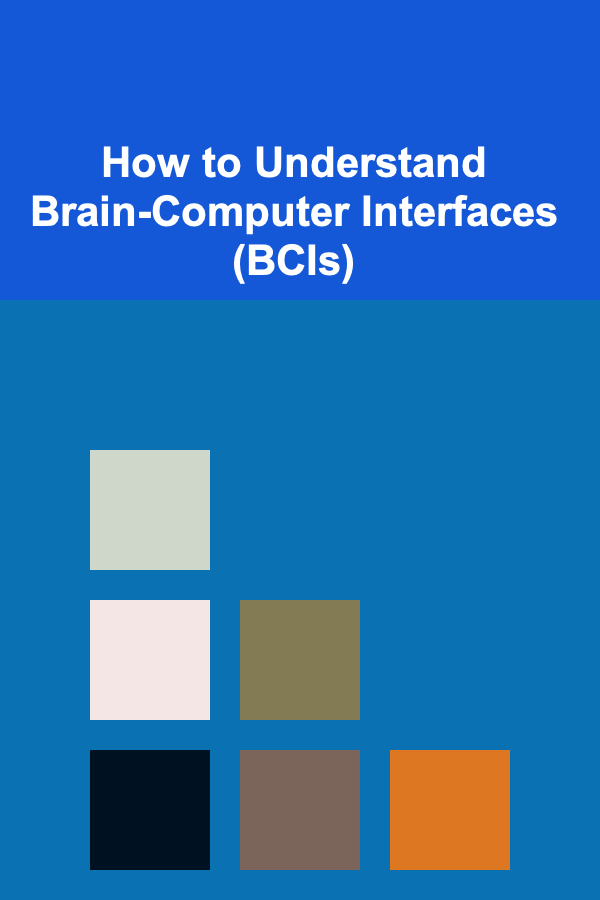
How to Understand Brain-Computer Interfaces (BCIs)
ebook include PDF & Audio bundle (Micro Guide)
$12.99$8.99
Limited Time Offer! Order within the next:

In the last decade, the advancement of technology has led to the development of systems that push the boundaries of human capabilities. Among these innovations, Brain-Computer Interfaces (BCIs) stand out as one of the most fascinating and promising fields of study. BCIs provide a direct communication pathway between the human brain and external devices, enabling individuals to control technology using just their thoughts.
In this article, we will delve into the fundamental concepts of Brain-Computer Interfaces, explore their types and applications, understand the science behind their functionality, and discuss their potential and challenges. By the end of this piece, you will gain a clearer understanding of BCIs, their future, and how they are shaping the world of technology, medicine, and beyond.
What is a Brain-Computer Interface?
A Brain-Computer Interface (BCI), also known as a Brain-Machine Interface (BMI), is a technology that enables direct communication between the brain and external devices. The primary function of a BCI is to capture and interpret brain signals, translate them into actionable commands, and use those commands to control devices, machines, or digital systems.
BCIs work by detecting electrical activity in the brain, typically via non-invasive methods like electroencephalography (EEG), or invasive techniques like implanting electrodes into the brain. The information gathered from the brain signals is then processed and converted into commands that control external devices, such as prosthetic limbs, robotic arms, or even video game avatars.
In simpler terms, BCIs allow the brain to "talk" directly to a computer or device, bypassing traditional input methods like keyboards, touchscreens, or even speech.
The Components of a BCI
A BCI system typically consists of four main components:
- Signal Acquisition: This is the first step in the BCI process, where the brain signals are captured. Depending on the type of BCI, this may involve placing electrodes on the scalp (non-invasive) or implanting electrodes directly into the brain (invasive).
- Signal Processing: Once the signals are acquired, they must be cleaned and processed. This step involves filtering out noise and extracting relevant features from the brain's electrical activity to interpret the user's intent.
- Translation Algorithm: After processing the signals, the system uses a translation algorithm to convert the brain activity into commands that can control external devices. This may involve machine learning techniques to refine the translation accuracy over time.
- Output Device: The final component is the output device, which could be anything from a computer cursor, a robotic prosthetic, a communication tool, or even a robotic exoskeleton.
Each of these components plays a critical role in ensuring the BCI operates smoothly and provides users with a seamless experience.
Types of Brain-Computer Interfaces
BCIs can be categorized into different types based on the method of signal acquisition and their intended applications. Broadly, BCIs can be classified as non-invasive, invasive, and semi-invasive.
1. Non-invasive BCIs
Non-invasive BCIs are the most common and widely used type. They do not require any surgical implantation and instead rely on external sensors to capture brain activity. The most popular non-invasive technique is Electroencephalography (EEG), which involves placing electrodes on the scalp to measure electrical activity in the brain.
Electroencephalography (EEG)
EEG is one of the oldest and most well-established methods for monitoring brain activity. It measures the electrical signals generated by neurons in the brain and records them through electrodes placed on the scalp. EEG-based BCIs are typically used for applications like controlling a computer cursor or playing video games through thought alone.
While EEG is non-invasive and easy to use, it does have limitations. The resolution of the brain activity captured is relatively low compared to invasive methods, which means that the precision and accuracy of the signals may not be as high. However, EEG-based BCIs have seen considerable success in medical applications, such as aiding individuals with disabilities, for example, enabling individuals with paralysis to communicate through a virtual keyboard.
Functional Near-Infrared Spectroscopy (fNIRS)
Another non-invasive BCI method is Functional Near-Infrared Spectroscopy (fNIRS), which uses light to measure changes in blood oxygenation levels in the brain. This technique can provide valuable insights into brain activity and has been used in BCIs that require longer duration of interaction and greater accuracy than EEG can provide.
While not as common as EEG, fNIRS holds potential for more complex applications due to its ability to detect deeper brain activity and offer more precise control for the user.
2. Invasive BCIs
Invasive BCIs, as the name suggests, involve surgical procedures to implant electrodes directly into the brain. These electrodes capture much more precise signals compared to non-invasive methods, leading to higher accuracy and functionality. They are often used in medical research or by individuals with severe disabilities.
Electrocorticography (ECoG)
Electrocorticography involves implanting electrodes directly on the surface of the brain (the cortex) to measure electrical activity. This method provides high-resolution data and has been used in BCI applications that require fast, accurate control, such as controlling robotic arms or enabling direct communication in patients with locked-in syndrome.
Although ECoG provides high-quality data, it comes with significant risks due to the invasive nature of the procedure. It is generally used in cases where other methods have not been effective or where higher precision is required for the task at hand.
3. Semi-invasive BCIs
Semi-invasive BCIs represent a compromise between non-invasive and invasive methods. These systems involve placing electrodes inside the skull but not directly into the brain tissue. This approach provides higher resolution signals than non-invasive methods, while avoiding the risks associated with fully invasive procedures.
One example of a semi-invasive method is the use of subdural electrodes, which are placed beneath the skull but above the dura mater, the protective layer surrounding the brain. This type of BCI offers a balance between signal quality and safety, making it an appealing option for certain applications.
How Brain-Computer Interfaces Work
To better understand how BCIs function, it is important to explore the process in more detail. The primary goal of a BCI system is to translate brain activity into actionable commands. This process can be broken down into several stages:
-
Brain Signal Acquisition The first step is to measure brain activity. As mentioned earlier, this can be done using techniques like EEG, fNIRS, or invasive methods like ECoG. The brain produces electrical signals, which are detected by electrodes.
-
Signal Processing and Feature Extraction Once the signals are acquired, they are processed to remove noise and artifacts that could interfere with interpretation. The brain signals are then analyzed to extract features that reflect the user's intentions. For example, in an EEG-based BCI, these features may include specific patterns of brain wave activity associated with certain thoughts or actions.
-
Machine Learning and Pattern Recognition To translate brain activity into meaningful commands, many BCIs use machine learning algorithms to recognize patterns in the brain's electrical activity. The system "learns" to associate specific brain patterns with particular actions, improving over time as the user interacts with the system. This phase involves training the system to increase accuracy and responsiveness.
-
Command Output Finally, the system generates a command based on the recognized brain pattern and sends it to an external device. This could be controlling a cursor on a screen, operating a robotic limb, or even facilitating communication through speech synthesis.
Applications of Brain-Computer Interfaces
BCIs have a wide range of potential applications across various fields. Some of the most significant and promising areas include:
1. Medical Applications
BCIs have been instrumental in improving the quality of life for individuals with disabilities. For example:
- Prosthetics Control: BCIs can be used to control robotic prosthetic limbs, allowing individuals who have lost limbs to regain some level of independence and functionality. The user can think about moving their prosthetic limb, and the BCI translates their brain signals into the corresponding movement.
- Communication for Paralysis Patients: For individuals with conditions like locked-in syndrome, BCIs offer a lifeline for communication. By detecting subtle brain activity, BCIs can allow these individuals to control a cursor or generate speech via a computer.
- Neurorehabilitation: BCIs are also used in neurorehabilitation, helping patients recover motor functions after a stroke or traumatic brain injury. Through brain training exercises, BCIs can promote neural plasticity and assist in the rehabilitation process.
2. Gaming and Virtual Reality
The gaming industry has embraced BCIs to enhance user experiences. With BCIs, players can control video game characters, navigate virtual environments, and interact with games using only their thoughts. This adds a new dimension to gaming, making it more immersive and intuitive.
In addition, BCIs have been integrated into virtual reality (VR) environments, providing users with a more seamless and engaging experience. BCIs can help create virtual environments that respond to the user's brain activity in real-time, making VR more interactive and personalized.
3. Military and Defense
In the defense sector, BCIs have potential applications for controlling advanced military systems, such as unmanned aerial vehicles (UAVs), drones, and other robotic systems. Through BCI technology, soldiers could control machines directly using their thoughts, enabling faster decision-making and more effective coordination in the field.
4. Brain-Controlled Technology
Beyond prosthetics and medical applications, BCIs could revolutionize many industries by enabling brain-controlled technology. This could include controlling machinery, operating vehicles, or even performing complex tasks in fields like manufacturing and healthcare.
Challenges and Future of BCIs
Despite the immense potential of BCIs, several challenges remain:
- Signal Quality and Accuracy: Achieving accurate and reliable signal acquisition is a significant challenge, particularly in non-invasive BCIs. The quality of brain signals can be affected by noise, artifacts, and external factors, which can hinder the system's performance.
- Safety and Ethics: Invasive BCIs come with significant health risks due to the surgical implantation of electrodes. Additionally, there are ethical concerns about privacy and the potential misuse of BCI technology.
- Cost and Accessibility: Many BCI systems, particularly invasive ones, are expensive and require specialized medical expertise. Making BCIs more affordable and accessible will be essential for wider adoption.
- Regulation and Standards: As BCI technology continues to evolve, there is a need for clear regulations and standards to ensure safety, privacy, and ethical use of the technology.
Despite these challenges, the future of BCIs is promising. Continued research and development are likely to lead to more sophisticated, efficient, and user-friendly systems. Advances in machine learning, materials science, and neuroscience will contribute to overcoming existing limitations, enabling BCIs to be integrated into everyday life.
Conclusion
Brain-Computer Interfaces are one of the most exciting technological frontiers, with the potential to revolutionize numerous aspects of human life, from healthcare to gaming and beyond. By enabling direct communication between the brain and external devices, BCIs open up new possibilities for individuals with disabilities and provide a deeper understanding of the brain's function.
While significant challenges remain, the continued advancement of BCI technology promises to bring about transformative changes, allowing us to interface with machines and technology in ways previously thought impossible. As we unlock the potential of BCIs, we move closer to a future where the boundaries between the human brain and technology are increasingly blurred.
Reading More From Our Other Websites
- [Home Pet Care 101] How to Make Your Home a Great Place for Multiple Pets
- [Home Lighting 101] How to Use Color-Changing Lights to Transform Your Home's Ambiance
- [Personal Investment 101] How to Use Dividend Reinvestment to Grow Wealth
- [Organization Tip 101] How to Set Up an Efficient Study Schedule
- [Hiking with Kids Tip 101] From Sketch to Print: Crafting Durable Child‑Friendly Trail Maps for Outdoor Fun
- [Organization Tip 101] How to Make the Most of Your Recipe Collection by Rating Favorites
- [Personal Care Tips 101] How to Use a Hair Mask to Enhance Volume in Thin Hair
- [Home Space Saving 101] How to Create Hidden Storage Solutions in Your Home
- [Home Storage Solution 101] How to Transform Your Bathroom with Clever Vanity Storage Solutions
- [Home Budget 101] How to Budget for Home-Based Business Startup Costs

How to Build a Portfolio to Attract Translation Clients
Read More
How to Create a Comprehensive Financial Plan for Couples: A Step-by-Step Approach
Read MoreHow to Develop a Customer Feedback Management Checklist for Tracking Key Metrics
Read More
How to Make Money with AI and Deep Learning-Based Products
Read More
How to Store and Organize Quilting Supplies Effectively
Read More
How to Spot Misinformation in Pandemic Reporting
Read MoreOther Products

How to Build a Portfolio to Attract Translation Clients
Read More
How to Create a Comprehensive Financial Plan for Couples: A Step-by-Step Approach
Read MoreHow to Develop a Customer Feedback Management Checklist for Tracking Key Metrics
Read More
How to Make Money with AI and Deep Learning-Based Products
Read More
How to Store and Organize Quilting Supplies Effectively
Read More